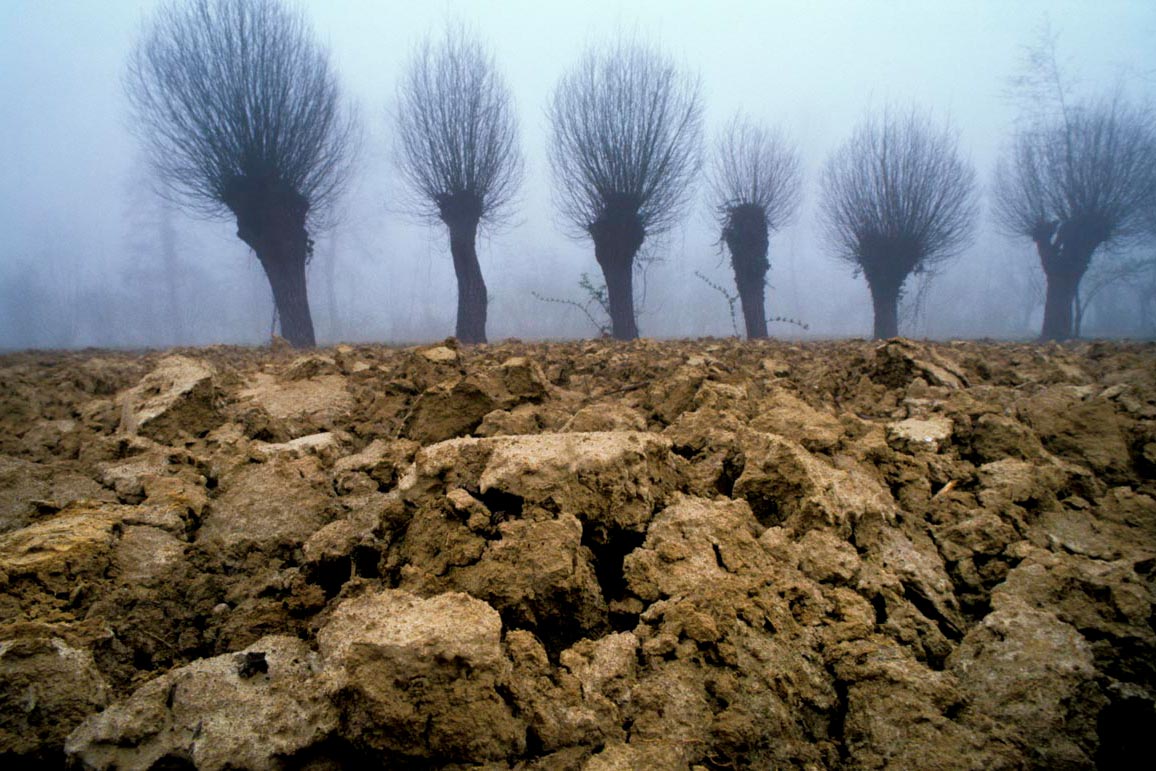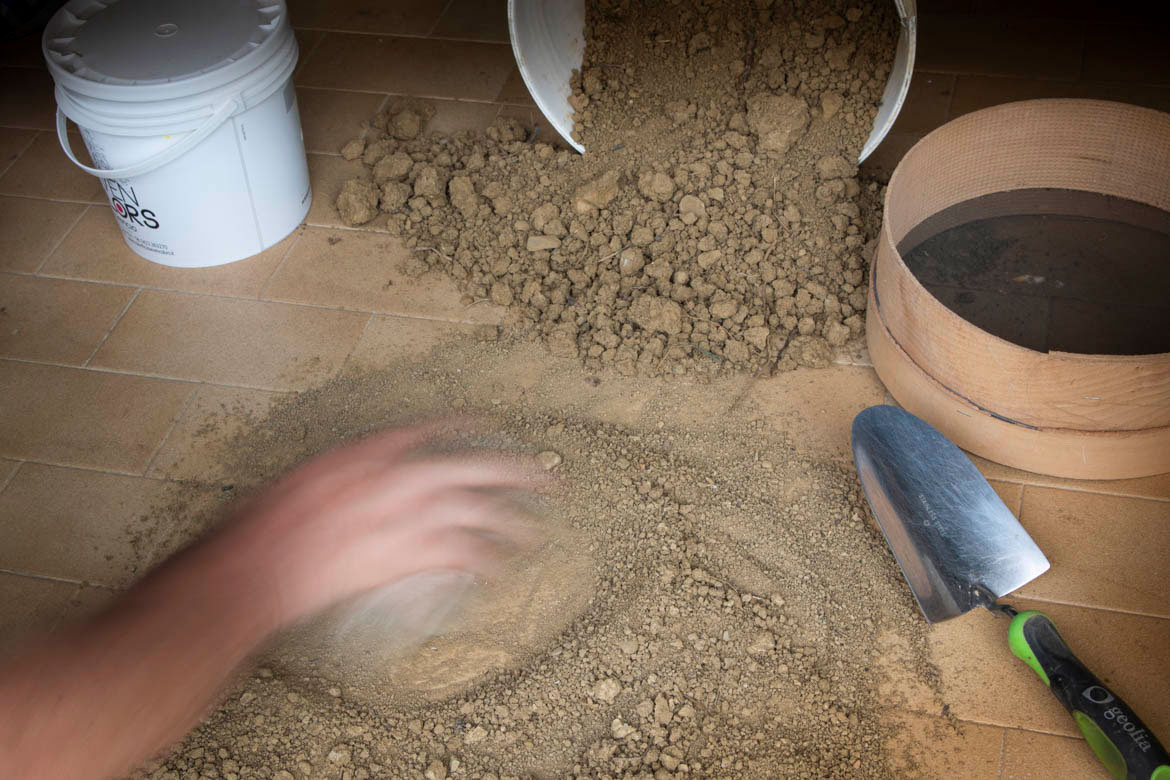metamorfosi@Radicchio di Treviso Rosso Tardivo IGP cm. 300 x 60 x 5 Kg. 44
ORTO-GRAFIE
LANDS OF PHOTOGRAPHY
What does the land have to do with photography? I have combined this unusual combination since I tried to print my images directly on native lands of fields and vegetable gardens, Geo-Identity lands as I define them.
The result is material works, some photographs and some sculptures, real bas-reliefs that I present as “photographic sculptures” and that I thought of calling Orto-Grafie.
A definition that refers to the photographs from which they originate, but which also suggests an orthogonal, volumetric dimension, and a sort of spelling also intended as an imaginary language of vegetable gardens and vegetables.
To realize this idea I had to undertake an experimental path that over time has also revealed a fascinating, creative and artistic opportunity to physically intervene in the process that transforms a photographic image by molding it into a photographic sculpture. I have supported seemingly very distant gestures, intertwining the use of recent digital printing technologies to a newfound figure of photographer-alchemist who has to prepare the surfaces to print on.
And with the lands I created a physical contact and almost intimate, I crushed them with a stone, sifted and breathed, palpandole with dusty hands, “dirty” someone would say. Those same hands that, just before, had caressed the computer keyboard and operated with a graphic tablet to trace accurate outlines. A curious and apparently unlikely alternation in which the virtual world of layers, stitching and contrast masks has been mixed with the ancestral world of ancestral gestures with a tribal flavor.
The Orto-Grafie represent the most evident and significant expression of my profound dualism, the point of equilibrium and the answer to the need to bring together imaginary and real, abstract and tangible, dream and matter.
PATH
Without precise references and without knowing where I would have arrived, supported only by the advice of Eva and Silvia, two restorative friends, this journey of mine has once again begun with a field of radicchio,
Collecting land around Italy was in itself already an experience, I traveled and met people and stories related to the territory, at work, to the passion, I came into contact with some of the many realities, sometimes punctual, which together they constitute that immense heritage of cultural and cultural diversity that make Italy an absolute world leader.
With the ground crushed in powder it was necessary at this point to prepare a mouldable mixture. I have experimented with various alchemies and developed various operating methods in order to fix, even in succession, in a stable and lasting way the lands to a support. Following a model drawn in draft I modeled the shapes and the reliefs and then let it dry with care and attention. An articulated and demanding phase, in part very artisanal, but partly qualified by interventions, albeit simple, treated with methods and tools typical of sculpture. At this point there was nothing left but to proceed with the printing phase. It was not and is not easy to find a laboratory available to risk damage to expensive printheads to treat these surfaces certainly not planar. Finally, somebody convinced him, however, finding, as expected, results that are quite erratic, sometimes unacceptable, so much so that they have to completely repeat the printing operation after restoring the surfaces themselves. Finally, on the printed panel it was highlighted the need to make some manual corrections to remedy the limitations of a planar printing process performed on a bas-relief. They therefore had to intervene with careful adjustments and adjustments made with chisels and rasps, brushes and colored pigments.
In many Orto-Grafie, all those made with “precious” lands, I thought of applying a bronze plate on the front surface of the work in which I certify the authenticity of the origin of the earth itself (Geo-Identity).
PHOTOGRAPHIC SCULPTURES
In the lands I partly sacrificed color and photographic definition, but I found a precious, intriguing and indispensable natural harmony. I also found the volumes and the tactile consistency I was looking for,
The “poor” essence of the earth has the intrinsic ability to transmit a natural and sober harmony that balances the disruption of the colored photographic surfaces, so as to create a pleasant balance. A primigenial force so powerful as to radiate a surprising empathy, perceptible only through direct contact. The Ortho-Grafie are to be touched.
The images blend with the earth itself, adapting itself to its irregular surface, following its curves and small reliefs, colliding with roughness and stones, sometimes fading to the point of becoming lost in a living material, thirsty for liquid and color. The results are only partly predictable, the natural elements and processes can never be completely controlled, nor are they completely controlled by my will.
The result is photographs that are real and authentic fragments of garden and countryside, to look at and to caress and sometimes, experimentally, even to smell. In fact, in collaboration with the perfumer and “nose” Roberto Dario, to the tactile one I tried to add also an olfactory sensorial component, characterizing the subject with its own perfume … the work on Cherry of Marostica that smells of cherry, that of wine Prosecco from prosecco, the earth itself that smells of Earth.
Many Orto-Grafie are made in such a way as to present a deep network of cracks, a typical characteristic especially of parched and suffering lands, a peculiar character through which I also intend to highlight suffering for the unbridled consumption of soil we are witnessing in our time.
Each Orto-Grafia is born from a project designed to tell a territory and its product, with a style never descriptive, but rather addressed to graphic and sometimes symbolic aspects, a minimal language built with the use of one or more photographic images, to whole times but more often cut out so as to leave always visible a part of natural lands.
Photography and matter become a single indissoluble element, at the same time object and subject.
A unique and unrepeatable work.
METAMORFOSI, the project
Attracted by the incredible chromatic variability of the leaves of the Red Radicchio di Treviso in the field and intrigued by the repetitive graphic already evident in a series of shots taken up to that moment,born the idea
“Metamorphosis @ Radicchio di Treviso Rosso Tardivo PGI” is the result of the combination and fusion of a selection of 12 shots arranged in seasonal progression. It is a sort of precious and colorful “Missoni” natural, but it is also an expression of the cultural and cultural journey of this product.
I realized the transposition of this photographic history on native land only after a couple of years, a demanding result of a very complicated work that lasted several months. A work certainly … of weight, with its 44 Kg. And 300 cm x 60 x 5 thickness is in fact the biggest work that I have produced so far. From that moment on, I feel obliged to specify this unusual and unexpected characteristic, at least in the world of photography.
















